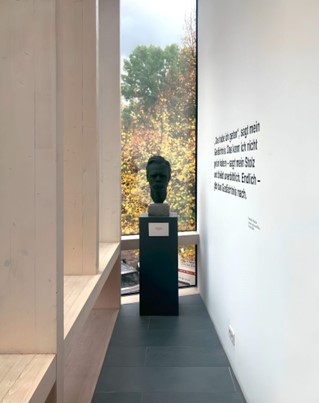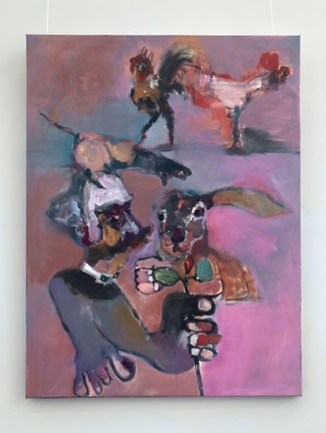Nietzsche and Cyborgs
The International Nietzsche Congress 2025
Nietzsche and Cyborgs
The International Nietzsche Congress 2025


Under the topic Nietzsche's technologies International visitors were once again invited to the Nietzsche Society conference in Naumburg an der Saale this year. In the period from October 16 to 19, in addition to various lectures, a film screening and a concert, there was also an art exhibition to visit. Our author Emma Schunack was there and reports on her impressions. Your question: How can Nietzsche's technologies find expression in the technological age?
Friedrich Nietzsche himself spent many years of his childhood and youth in the city on the Saale. His family home still stands today in the vineyard 18. In 2008, the Friedrich Nietzsche Foundation Naumburg was founded here, which operates the Nietzsche Documentation Center as a publicly accessible research and cultural center, which once again serves as the venue for the Nietzsche Congress this year.
If you get to the Congress from the train station, you first come across the former Nietzsche family home. A winding house surrounded by wine, the ground floor of which is now a small bookshop with a selection of Nietzsche's writings. If you go just a few steps further, the Documentation Center is located right next to the historic Nietzsche House as a modern new building with bright walls and large window fronts. Inside the building, there are light-filled rooms on three floors, which provide space for a library, an archive, two exhibition areas and two plenary rooms. There are Nietzsche busts in the corridors, and large lettering with quotes from the philosopher is repeatedly affixed to walls and stairs.
The conference, chaired by Edgar Landgraf, Catarina Caetano da Rosa and Johann Szews, starts on Thursday afternoon with various greetings, including from the Director of the Friedrich Nietzsche Foundation, Andreas Urs Sommer, and the Chairman of the Nietzsche Society e.V., Marco Brusotti. The talks given this weekend on Nietzsche's technologies are divided into various sections, from “Cultural and Body Techniques”, “Nineteenth-Century Techniques” and “Anthropo and Media Techniques” to “Techniques of Discipline and Subjectification” to “Linguistic and Rhetorical Techniques.” In this way, the term technology is broadly defined and provides a basis for various interpretations.

I. Human Thinking as a Technique
What mental techniques must humans practice in order to think like Nietzsche? Emanuel Seitz, research assistant at the University of Basel, will address this question and its implications in his presentation Nietzsche, a stoic of intoxication. The techniques of a mental exercise. Seitz is primarily concerned with the questions: What do I have to do to become Nietzsche? Can Nietzsche be described as a Stoic? To answer this question, Seitz first explains three techniques for the Stoa's spiritual reflection: the practice of thinking, desire and drive. It should be possible to learn those exercises or techniques. They aim to form an appropriate idea of the true value of things through reflection. With the help of the exercises, humans should reach value judgments that are not just subjective, they should practice distance and look down from the universe like God. Practicing these techniques of thinking creates a kind of cosmic consciousness, as the Stoa teaches, which leads to a new form of freedom of judgment. It is only by practicing these exercises that people are able to reevaluate existing values.
Seitz combines these Stoa exercises with Nietzsche's own practice The technique of philosophy as an art of living, It is about action, not knowledge, According to Seitz. He argues that although Nietzsche comes to completely different results than the Stoa, not to a humanist ideal of compassion, but to self-discipline and selfishness as a passion. Although Nietzsche despises moralism, he deals with questions about The will for cosmic justice. Seitz therefore argues that Nietzsche could very well be described as a Stoic in terms of the method of his thinking, in complete contrast to the content of his philosophy. In conclusion, he therefore expressly pleads for Nietzsche to be taken seriously as a technician of thought.

II. Post-humanist Perspectives on Nietzsche
In line with this year's theme of the congress, some of the lectures relate to post-humanist epistemology and Science and Technology Studies. Babeth Nora Roger-Vasselin places particular focus on post-humanist positions, who in her presentation Incorporation out of business. Incorporation seen as a technique Nietzsche's concept of incorporation attempts to combine with the figure of a cyborg after Donna Haraway.
Roger-Vasselin regards Nietzsche's concept of incorporation as a technique of individuation. This is what incorporation describes as an organism actively simulates its sensory experience, a formative process that all living beings share. Roger-Vasselin describes this process of incorporation as technique, since it is not natural or innate to us, it is instead the result of education based on individuation. With this technique These are standardized processes through forms and rhythms.
But what could that technique of incorporation look like in the technological age? Roger-Vasselin argues in this context using the figure of the cyborg and refers to Donna Haraway. The cyborg is described by Haraway as “a cybernetic organism, a hybrid of machine and organism, a product of both social reality and imagination.”1, a creature that is neither natural nor artificial, but both at the same time and nothing alone2. For Haraway, cybernetic organisms are neither nature nor culture, but have always been natural culture3. Conceptually, with the figure of the cyborg, Haraway blurs supposed boundaries between humans, animals and machines and establishes a way of thinking of difference beyond dualisms4: “To be one is always to become together with many”5. And so Roger-Vasselin argues that community forms in the technological age should be collectives of cyborgs.
Matthäus Leidenfrost presents another post-humanist perspective on Nietzsche in his presentation Animal husbandry and human taming. Nietzsche on anthropotechnical practices, In which he deals with the relationship between animals, humans and technology in Nietzsche. He discusses how Nietzsche himself described humans as a sick animal that has been tamed with the tools of culture and hides behind clothing and morals. According to Nietzsche, humans living in the flock are deficient and deprived of their own investments. In this way, people themselves suffer from life. At this point, Leidenfrost is referring to Peter Sloterdijk, who, in this context, formulates an invitation to people to recognize their own animality and to become part of an open bio-cultural existence. Illness is not a rigid state here, it is decay, but also recognition and a new beginning, an opportunity for growth. Leidenfrost continues to refer to current trans- and post-humanist discourses and he too refers to Donna Haraway at this point. He reads Nietzsche's reflections in this regard as an invitation to humans to open themselves up in an affective dimension in the age of perfection and within their own domestication of their own animality, in the spirit of the end of So Zarathustra spoke: “He denied and brewed all their virtues from the wildest, bravest animals; only then did he become — a human being. ”6

III. Aesthetic Experience
In addition to scientific lectures, the congress also offered aesthetic approaches to Nietzsche's thinking. This is how the exhibition was Nietzsche's Echo. Pictures of contradictions opened by painter Conny Gabora. The works shown are inspired by Nietzsche and his thoughts and life conflicts. They are intended to represent an artistic homage to the philosopher. In addition, the German film premiere of Nietzsche's landscapes in the Upper Engadine by Fabien Jégoudez and on Saturday evening, pianist Silvia Heyder and singer Julia Preußler gave a concert at which they performed some selected from Nietzsche's compositions. We were thus able to express Nietzsche's thinking not only in scientific form, but also in aesthetic experience.
IV. Conclusion
How can Nietzsche's technologies find expression in the technological age? The Congress in Naumburg has shown how Nietzsche can be read today as a technician of thought, a philosophy of doing, not of mere knowledge. This thinking provides the basis for a view of humans as a being that recognizes their animality and their integrations and enrolls itself in collectives of cyborgs and in the open biocultural network of being: “We are all chimeras, theorized and manufactured hybrids of machines and organisms; in a word, we are cyborgs.”7.
The photographs are by the author. The article image shows a Nietzsche bust by Fritz Rogge from 1943 on the first floor of the Nietzsche Documentation Center.
Literature
Fink, Dagmar: Becoming a cyborg: Possibility horizons in feminist theories and science fiction. Gender Studies. Transcript Verlag.
Haraway, Donna: The encounter of species. In: Texts on animal theory, published by Roland Borgards, Esther Köhring and Alexander Kling. Reclam's universal library, No. 19178. Reclam.
Haraway, Donna: Manifestly Haraway. Posthumanities 37th University of Minnesota Press.
Footnotes
1: “[A] cybernetic organism, a hybrid of machine and organism, a creature of social reality as well as a creature of fiction” (Haraway, Manifestly Haraway, p. 5; translation by the editor).
2: Cf. finch, Becoming a cyborg: horizons of opportunity in feminist theories and science fictions, p. 9 f.
3: See ibid. p. 59 et seq.
4: See ibid. p. 9 f.
5: Haraway, The encounter of species P. 239.
6: From science.
7: “We are all chimeras, theorized and fabricated hybrids of machine and organism; in short, we are cyborgs” (Haraway, Manifestly Haraway, p. 7; translation by the editor).









